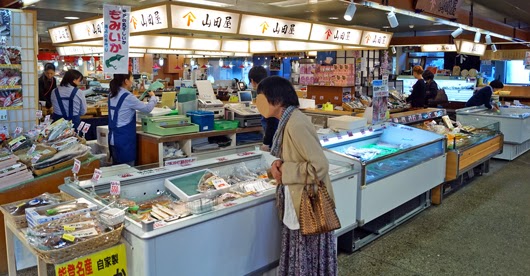< 1. head of a Buddha,
2nd century, Mathura >
We have previously looked
at Buddha statues that began in
Gandhara of Pakistan.
From this issue, we look at Buddha statues that began in Mathura of the inland regions of India.
The Buddha statues that
were born in these two places varied in some expression while having the same
religious meaning.
There were a fusion of
religion and culture, and impulses originating in foreign culture.
Through the artistic
expression of the Buddha statue, I investigate the relation of symbol,
religion, and culture.
前回まで、パキスタンのガンダーラで始まった仏像を見ました。
今回から、インド内陸部のマトゥラーで始まった仏像を見ます。
この2箇所で誕生した仏像は、同じ宗教的意義を持ちながら、表現が若干異なります。
そこには宗教と文化、外来文化と自国文化の融合と触発があります。
仏像の美術的表現を通して、宗教、文化、象徴の関わりを探って行きます。
< 2. seated Buddha
Triad, 2nd century, Ahicchatra >
Buddha statue of Mathura
The head of figure 1 is
a round face and has thick lip than the heads of Buddha in Gandhara, and is
tonsured and rolls up long remainder hair.
The heads of Buddha in
Gandhara bundle up rich rippling hair.
The Mathura statues used
red sandstone and the Gandhara statues used black schist.
The Buddha statue of
figure 2 has the oldest form of Mathura unlike Gandhara.
It are features that the head that I
mentioned above, the thin clothes that hung only on unilateral shoulder, and
the homely expression giving you a sense of vitality.
Although there was also
the seated Buddha Triads in Gandhara, this triad is not known whether two
attendant statues of the right and the left are Deva (Indra, Brahma) or
Bodhisattva.
The left statue has a Vajra( beetle) that
Indra should have, but wears a scarf and a short breechcloth.
Therefore it is subject
to the influence of western Gandhara.
マトゥラーの仏像
図1の仏頭はガンダーラの仏頭と比べると丸顔で肉厚の唇が肉感的で、頭は剃髪し残りの長い髪を巻き上げている。
ガンダーラでは豊かな波打った頭髪を束ねている。
マトゥラー像は赤色砂岩を使用し、ガンダーラ像は黒色片岩を使用している。
図2の仏像は、ガンダーラと異なるマトゥラーの最古層の形式を持っている。
前述した頭部と片方の肩だけに掛けた薄い衣、素朴で生命力を感じさせる造形が特徴です。
ガンダーラにも仏三尊像があったが、この左右の脇侍は天部(帝釈天、梵天)か菩薩かは不明です。
左像は天部が持つべき金剛杵を持つが、スカーフを巻き、短い腰布をしているので、西方のガンダーラの影響を受けている。
< 3. standing Buddha, 2nd century, Mathura >
The expression of the swelling of clothes
at the statue’s neck and the hanging the clothes on the both shoulders is the
same as Gandhara.
At a later time, Gupta
Empire reaching prosperity of Buddhist art inherits the expression of U-shaped
pleats of the cloth that hung down from the front.
この像の両肩に掛かっている衣や襟元の膨らみの表現はガンダーラと同じです。
前面に垂れ下がった衣のU字型の襞は、後に仏教美術の隆盛を迎えるグプタ朝様式(4~6世紀)に受け継がれる。
< 4. head
of a Bodhisattva, 2nd century, Mathura >
< 5. seated Buddha, 3rd
century, Saheth-Maheth >
The head hair of this
statue becomes a lot of small and spiral hair and the cross-legged pose lacks
total balance because the legs are short.
With the decline of
Kushan Empire, the stylization might have advanced.
この像は頭部が螺髪になっているが、組んだ足が短く全体のバランスを欠いている。
クシャーン王朝の衰退と共に、様式化が進んだのだろうか。
The feature of Mathura Buddha statue
The Gandhara Buddha statue meditates, but
the early Mathura Buddha statue opens the eyes.
Gandhara Buddha statue has sloping shoulders, but Mathura Buddha statue has square shoulders, therefore it is
healthy image.
Most of seated Buddha statues in Gandhara
link the both hands, but most of things in Mathura raise the right hand and
turn the palm of the hand at the front.
This is a meaning that removes
people's fear and uneasiness.
Next time, I look at why Buddha statue was born in Mathura.
マトゥラー仏像の特徴
ガンダーラの仏像は瞑想しているが、初期のマトゥラー仏像は目を開いている。
ガンダーラ像は撫で肩だが、マトゥラー像は肩がいかつく張って健康的です。
ガンダーラの仏陀座像の多くは両手を結んで瞑想しているが、マトゥラーのものは多くが右手を挙げ、手のひらを正面に向けている。
これは施無畏印と呼ばれ、人々の恐れと不安を取り除く意味がある。
次回は、なぜマトゥラーで仏像が誕生したかを見ていきます。


































